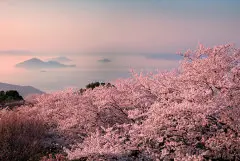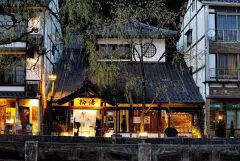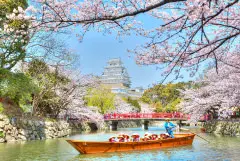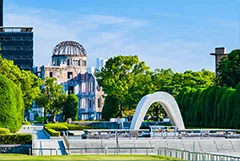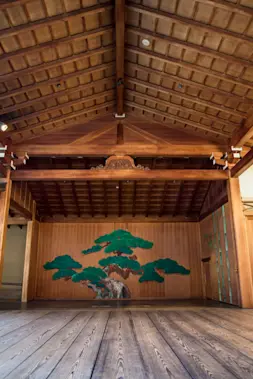Relaxing Stay
A Quiet Stay on one of Japan’s Cat Islands: Manabeshima

-
- DESTINATION NAME
- Okayama
-
- RELATED TAGS
-
- LAST UPDATED
- 30 March, 2021
The island of Manabeshima (真鍋島) had always topped my wishlist of places to visit, even before my first trip to Japan. This might seem strange for a tiny island in the middle of the Seto Inland Sea. But Manabeshima had already sparked my interest for two reasons: first as a “cat island,” and second, as the subject of French author and illustrator Florent Chavouet’s book Manabeshima Island Japan. It was this book that had inspired me to seek out this quiet island with its tranquil lifestyle and enchanting scenery.
From the very first time I debarked on Manabeshima, I immediately fell under its spell. This island has since become a place where I often go to rest and recharge, an escape from the frenetic pace of Japan’s big cities. It was only recently, however, that I stayed for the first time at Shimayado Santora (島宿三虎), a solitary hotel built on a secluded beach—the ideal location to relax and release stress from the demands of everyday life, or simply a welcome pause during a busy itinerary.
Enjoy a gourmet seaside paradise at Santora lodge
I arrived in Manabeshima on the last ferry of the day. While the evening was still young back in the city, the sleepy island was already completely dark. The steep and narrow path that led to Santora was only partially lit, which made the less than 10-minute walk feel like an adventure. But soon enough, I recognized the silhouette of the lodge below as the owner Michiru Hisaichi came forward to greet me, worried that I might stumble in the night.
In the darkness, I could only imagine the surrounding idyllic landscape: a secluded bay between the hills and the sea, a sandy beach shaded by palms. Michiru led me to a Japanese tatami room inside the former elementary school building and invited me to come down for dinner as soon as I settled in for the evening.
Awaiting me at the dinner table was a fresh feast of seafood fished straight out of the waters around Manabeshima. As many of the fish in my plate were quite uncommon, Michiru brought out the now-famous book by Florent Chavouet, who had the excellent idea of illustrating a lexicon of the island’s local fishes. Most of these species have no English names, so the best way to learn about the flavors of sawara, hirame or suzuki is simply to taste them for yourself. Santora’s locally sourced dinner is not only a true delight for seafood lovers, but it’s also sure to please anyone with a curious palate.
With a full belly, I returned to my room to find a futon laid out on the tatami, newly covered with a winter duvet. Yet Michiru and Hironobu Hisaichi were the only ones minding the lodge, and both had been busy in the kitchen throughout dinner… such is the magic of omotenashi, typical Japanese hospitality! To end this perfect evening and prepare for a good night’s sleep, I enjoyed a relaxing soak under the stars in the steaming outdoor bath.
Following my hosts’ suggestion, I went down to the beach at dawn to watch the sunrise. I spent almost an hour alone on the sand, not even a cat to keep me company (they prefer to wait for the fishing boats to come into the harbor). The sky and the sea imperceptibly changed color, from the pastel pink of daybreak to a flamboyant orange that inflamed the beach and the lodge buildings, until finally, the sun emerged from behind the low silhouette of the nearby island of Sanagijima.
Santora’s typically Japanese breakfast was just as fresh as the dinner: savory fish miso soup, Japanese omelette, rice, salad, fruits, and other garnishes around the main dish of sole meunière! The owners keep a tank of live fish near the kitchen and cultivate their own vegetable garden in the back of the lodge, so you can imagine just how fresh the ingredients are at each meal.
Michiru and Hironobu said that ever since Florent Chavouet’s book was published, they often host European guests, especially coming from France, Italy, and Germany. They even mention this in Santora’s Japanese brochure: “Come see Manabeshima, a place that even fascinates foreigners.” If fans of Chavouet’s book invariably come to Shimayado Santora, it’s because this is where he stayed during the two months he spent on the island. The lodge retains many traces of the author’s sojourn, from an original drawing exhibited at the reception to an illustration on the paper envelopes for the chopsticks, not to mention a complete collection of his books. All are a heartfelt tribute to a guest who brought unexpected international fame to both Manabeshima and Santora lodge.
Honura village, the island’s cat headquarters
Shimayado Santora is such a paradise in itself that many people come to Manabeshima just to stay there. It’s only natural to want to spend time at the beach, but it would be a shame not to explore the rest of the island. With an area of 1.48 km2, Manabeshima includes two fishing villages, a road less than two km long, three shrines, one temple, around 200 human inhabitants… and a few dozen cats.
The resident cats attract visiting cat lovers and photographers, who are greeted by a feline welcoming committee at Honura Port. Manabeshima may not be able to compete with the famous cat hordes of Aoshima, but you will always find both groups and solitary cats simply going about their business around the harbor. Some come running toward you meowing and follow you through the alleys rubbing against your legs, while others pretend to ignore you, watching you out of the corner of their eye. As I was squatting down to photograph one of the cats, it jumped onto my lap and curled up, making itself comfortable. The island cats may be feral, but many are more than happy to make human friends.
View the panoramic Seto Inland Sea from Manabeshima Park
The narrow, winding alleys of the island villages are particularly picturesque and fascinating to explore. But there are few places to rest, especially when you want to have a picnic without inviting all the cats in the neighborhood to join you. For a break, follow the coastline west from the port until you reach the last houses; there you will see a stone torii marking the entrance to a path that leads up to Tenjin Shrine (天神神社), and beyond it, Manabeshima Fureai Park (真鍋島ふれあいパーク).
As surprising as it may seem for such a small island, Manabeshima has its own charming and carefully maintained public park. If the residents so proudly cultivate the flower beds, it’s because before Manabeshima became a “cat island,” it was a “flower island.” For a long time, the island’s main commercial activity was cultivating chrysanthemums. After production was relocated, the island began to decline both economically and demographically.
The hilltop park offers an impressive view of nearby Kitagijima island within the expansive Seto Inland Sea. It also provides everything you might need for a pleasant outing with family or friends, including picnic tables and a tempting playground with wooden structures.
Above all, don’t miss visiting the park if you find yourself on Manabeshima during sakura season. The park is full of cherry trees, still budding when I visited in early March, but promising the ideal setting for a truly peaceful hanami cherry blossom viewing.
How to get to Manabeshima island
Manabeshima can be accessed by ferry from Kasaoka Port (笠岡港). The journey takes either 45 minutes by express ferry or 75 minutes by regular ferry. There are eight round-trips daily.
See this page for detailed information on ferry schedules and prices.
Kasaoka Port is less than a 10-minute walk from Kasaoka Station (笠岡駅), which is a 40-minute train ride from Okayama Station. As Okayama is on the Tokaido-Sanyo Shinkansen line, Kasaoka can be reached quickly from the nearest cities: 1 hour 40 minutes from Kyoto or Osaka; 50 minutes from Hiroshima.
Visiting a cat island, tasting ultra-fresh local seafood, and staying at a secluded lodge by the seaside—Manabeshima offers a trio of pleasures for visitors who venture out to this small island in the heart of the Seto Inland Sea. Spending a few days and nights here not only makes an enchanting sojourn, but it’s also a way of supporting the local economy and sustaining Manabeshima’s unique island culture.
Photographs and text by Clémentine Cintré
RELATED DESTINATION
Okayama
The Okayama area has flourished as an area alive with various culture including swords, Bizen ware and other handicrafts. Because of its warm climate, fruits such as peaches and muscat grapes are actively grown there. It is also dotted with places where you can see the islands of the Seto Inland Sea.










